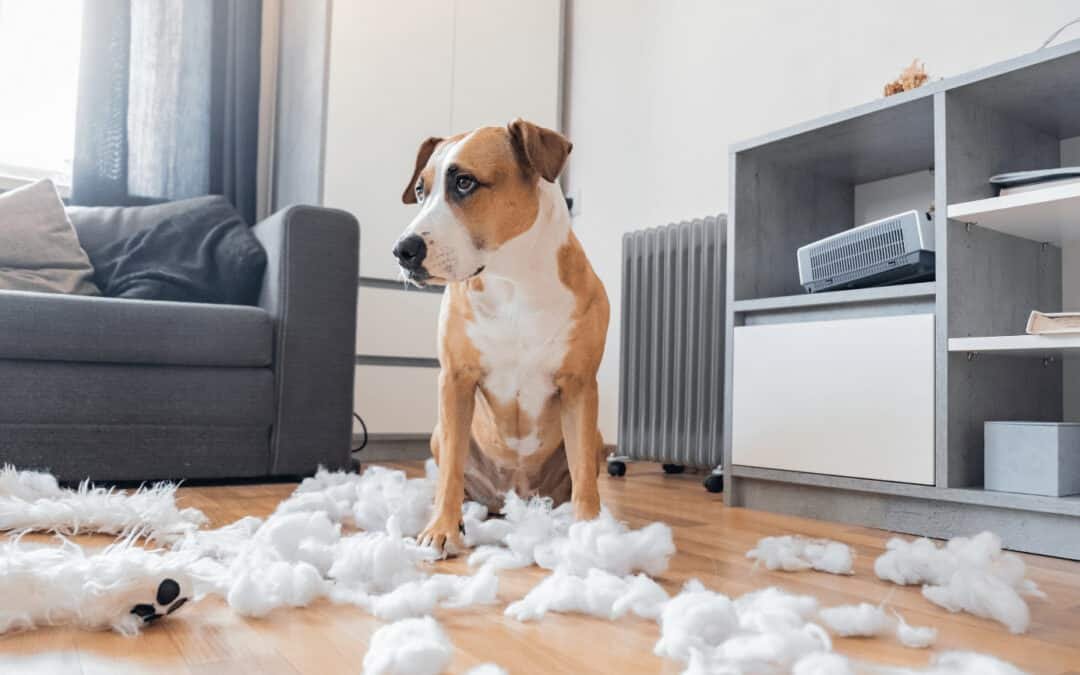It’s no secret that dogs can be destructive. You get home from work to find the legs have been chewed off your coffee table. And while puppies are teething we know they bite and chew stuff, rarely their toys, more often chair legs, their bed, or us. But what if it continues into adulthood? What does that mean and how do we stop it?
Understanding why an adult dog is destructive
When a client asks me to help with an adult dog who is destructive I ask myself three
questions:
1. Is the dog being worked enough?
2. Is the dog being exercised enough?
3. Is the dog able to express its prey drive enough?
So let’s break these down.
1. Is your dog being worked enough?
Dogs, as we all know are working animals. We might have to go back a few
generations, quite a few more generations with some, but their ancestors were bred
for a purpose and some dogs have a strong drive to do work – they need a job. If
they don’t have a job, some sort of focus in life, the boredom and frustration can
overflow in all sorts of ways. They might revert to type, a German Shepherd might
start guarding. Or they might carry out a behaviour which is totally unrelated, and
that’s when we see chewing and destruction start.
2. Is your dog being exercised enough?
This is much like the need for work. In fact in many ways, we take our dogs for a
walk every day because it is like giving them a job to do. A walk is both mental and
physical work. If your dog isn’t getting as much as they need of either of these
elements this can also lead to destructive behaviours coming out due to frustration.
3. Is your dog’s prey drive being satiated?
In some dogs the drive to chase and catch can be very high. Similar to meeting their
needs for physical and mental work we also need to make sure the dogs prey drive
is being met as much as it needs to be for your dog to be happy and balanced. I’ve
seen dogs not be able to settle because they have so much pent up prey drive and I
believe it can also be a reason for them to become destructive.
So what’s the solution?
Well, with most dogs it’s pretty simple, train your dog, walk your dog, play with your
dog.
Training your dog is giving your dog a job to do, and of course it comes with a myriad
of benefits. Keep sessions short, five to ten minutes two times a day is a good place
to start. You can lengthen the sessions as your dog’s attention span improves.
A walk should have three parts: working for you (walking on a lead at heel focussed
on you), their time to be a dog (off-lead or on a long line when they can sniff, mark
territory and do all the things dogs like to do), and then back on the short lead
working for you on the way home. This is what you might call a balanced walk.
Most toys sold for dogs replicate hunting. I like the toys that have the owner on one
end and the dog on the other. This builds the best possible relationship with the dog.
Flirt poles simulate the dog chasing prey and tug toys allow the dog to pretend to
bring down prey. These are primal urges, some dogs have them more than others,
but once you are allowing them to express themselves in this way you will have a
properly balanced dog and the destructive tendencies should melt away.
The rules of playing with your dog are that you should initiate the game, and you should decide
when it ends. Then give your dog a release command so they know they are free
and that you have finished the game.
The other thing to avoid
One last trick is to make sure you never leave your dog in an excited state. If you are
leaving the dog alone then make sure you are leaving the house calmly and the dog
is comfortably relaxed on his bed. If you walk out of the door when the dog is
bouncing off the walls then all that energy has to go somewhere, so don’t be surprised if
you get home and find your trainers have been given the treatment.
In summary
We are always trying to achieve balance in a dog for them to live their best lives.
Destructive tendencies in an adult dog are a sign that they are missing something.
The list above should give you a starting point to give your dog what they need.
Remember, these are not quick fixes. These tackle the route cause. It might take a
few weeks for your dog to settle and for the destruction to stop. Don’t get upset with
them while this process is happening, the dog doesn’t understand why you’re upset,
just make a note to yourself, “play with Fido before I go to work.”
Until next time, enjoy your dog.
Nick

